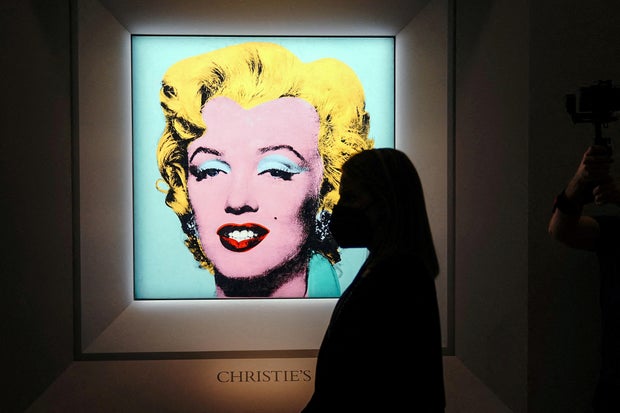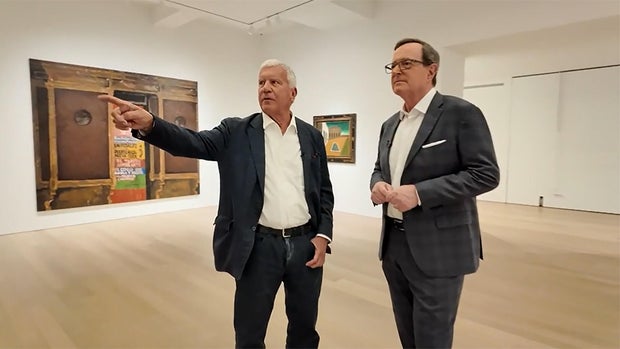In 2022, when Andy Warhol’s “Shot Sage Blue Marilyn” set an auction record for a 20th century artist at Christie’s, the winning bidder was Larry Gagosian. The final price, with fees: $195 million.
CARLO ALLEGRI / REUTERS
I asked, “That must have been a crazy moment?”
“When you’re bidding at that level,” Gagosian said, “your adrenaline is … it’s very exciting.”
“It’s a brutal business.”
“It’s a blood sport.”
“What do you love about this most?” I asked.
“I love the challenge,” Gagosian smiled. “I love winning.”
CBS News
Gagosian represents more than 100 artists, and shows the works of Picasso, Warhol, and de Kooning. His clients include billionaire mega-collectors like New York Mets owner Steve Cohen, music mogul David Geffen, and cosmetics heir Leonard Lauder. Gagosian said, “That’s why New York is such a great city for an art dealer, because you have all these super-competitive rich guys trying to (you know, in a certain way) outdo each other – ‘I got one.’ ‘Oh, I got one better.'”
Gagosian, who grew up in an Armenian family in Los Angeles, never had any formal art training. In the 1970s, he was working as a parking attendant. Then he saw somebody selling posters on the street. “I saw that and I said, ‘Jeez, I could do that.’ And so, I bought basically the same posters, I literally paid a dollar apiece, and then put a little aluminum frame on them and put ’em on a peg board and tried to get as close to twenty bucks as I could, which is a pretty good profit margin.”
He built it into a business, and started having shows. In 1981, a young New York artist caught his eye: Jean-Michel Basquiat. Gagosian bought three of his paintings on the spot. “And sadly, I sold them all. Wish I still owned them!”
He’d give Basquiat his first West Coast exhibition, which put Gagosian’s gallery on the map. “It was a big deal in L.A.,” he said. “We did the show and it was, like, mobbed. The buzz was – I’d never experienced anything like that in my gallery.”
But Gagosian knew that New York was the center of the art world, and in 1985, he relocated.
How was he received in the New York art world? “They didn’t like me,” he said. “I guess they thought I was gonna, you know, cause some trouble.”
“Well, you kinda did!” I said.
“I’d rather not go into that litany, but I was roughed up quite a bit by competitors, I think very unfairly.”
He earned a nickname, “Gogo,” which he says actually started when he was young. “When I was kid, my friends had a hard time pronouncing my name, Gagosian. And that’s really where it started. But then it became, people associate it with something else.”
But Gagosian made an important ally, the esteemed dealer Leo Castelli. On a walk together one day, Castelli stopped a non-descript man in the street: “And so I said, ‘Well, who was that?’ ‘Oh, that’s Si Newhouse.’ And I’ll never forget his very words: ‘He can buy anything.'”
Newhouse, who owned the Condé Nast magazine empire, would become Gagosian’s first big client. At Sotheby’s 1988 auction of Jasper Johns’ painting “False Start,” they sat side-by-side: “He didn’t want to be seen bidding,” said Gagosian. “So, he would literally nudge me when he wanted to bid. And I bid, I think it was $17 million. And he got the painting.”
It was a record for a living artist at the time. “It was, you know, like, jaw-dropping,” Gagosian said.
But that price seems almost quaint today.
I asked, “Do you think there’s a billion-dollar painting out there?”
“Maybe; I don’t see why not,” Gagosian replied. “A young artist, if he’s really talented, can sell for a million dollars.”
I asked Gagosian about the comments of one of his former rivals, Arne Glimcher of Pace Gallery, who said five years ago, “This market has nothing to do with art. It’s all about how fast one can make money.”
“You know, there’s a certain truth to what he’s saying,” Gagosian said, “but I don’t think it’s just about money at all. I don’t think, if people didn’t love art, you know, I think they wouldn’t buy it at that level. I don’t think it’s just an asset class. And it’s not just about money. It’s just gotten more expensive to buy really great art.”
“Do you think in any way it distances ordinary people from loving art?”
“No. I think it actually makes art seem more interesting. Wow! Somebody spent X amount of money for a painting? Wow, that’s fascinating!”
Gagosian – who’s had some high-profile romances, is single, and has no children – is still energized by the hustle. “I guess to a degree I thrive on it,” he said. “It gives you something to go for.”
“Why do you thrive on it?”
“Cause I’m tenacious. And because I like to win.”
“What’s the win for you?”
“The win is to keep it going. The win is to survive at the top. There’s no real finish line.”
But there is, of course. Gagosian turns 80 in April. And the man who GQ magazine called “The closest thing the art world has to a Caesar,” still has no plans of succession for his empire.
So, can there be a Gagosian without Gagosian? “I don’t know; that’s the question,” he said. “I don’t want to think it’s an impossibility. I think it’s a serious challenge. But I’m not ready to pass the reins. I enjoy it too much.”
I asked, “Are you ever gonna be, do you think?”
“No.”
“Well, it kind of means you’re, like, never at rest.”
“Well, there’s no time to rest, really. It’s overrated!” he laughed.
For more info:
- gagosian.com
- Images © Estate of Jean-Michel Basquiat. Licensed by Artestar, New York
- Images courtesy Gagosian
- © Jean Pigozzi, courtesy Gagosian
- © Cy Twombly Foundation, courtesy Gagosian
Story produced by Julie Kracov. Editor: Steven Tyler.








